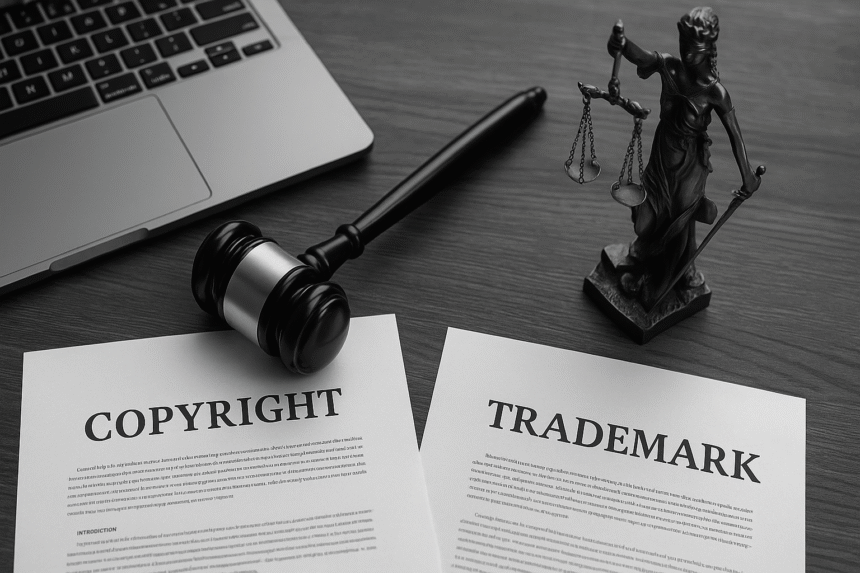Many founders, consultants, and small business owners get confused about the legal difference between a trademark and a copyright. They both protect intellectual property — but in very different ways. And if you get it wrong, you risk losing control of your brand or content.
This guide is for entrepreneurs, freelancers, legal consultants, and startup teams who need clarity on how to protect names, logos, designs, content, and original work. Below, we answer the most common questions to help you decide when to register a trademark and a copyright, and how each affects your business strategy.
Q1: What Is the Difference Between a Trademark and a Copyright?
A trademark and a copyright serve different functions in intellectual property law.
A trademark protects brand identifiers — like your logo, business name, slogan, or even a product packaging design — that distinguish your company in the market.
A copyright protects original creative works — such as books, software code, music, photos, blog posts, and videos — from being copied or used without permission.
Put simply:
- Trademark = brand identity
- Copyright = creative content
Both are types of intellectual property, but they serve different legal purposes.
Q2: Which One Should I Register First, Trademark or a Copyright?
It depends on your business activity.
If you’re launching a product or service brand, register your trademark first to secure your name, logo, or slogan.
If you’re a content creator (e.g., author, software developer, artist), you’ll want to secure your copyrights as you publish or release your work.
In many cases, businesses need both. For example, a software company may trademark its app name and logo while copyrighting the source code and design.
Q3: How Long Do Trademark and Copyright Protections Last?
Trademarks last indefinitely as long as you keep using them in commerce and renew your registration (usually every 10 years depending on jurisdiction).
Copyrights usually last for the life of the author plus 50 to 70 years, depending on the country.
So, trademarks require active use and maintenance. Copyrights are more passive — once granted, they automatically exist and endure.
Q4: Do I Have to Register a Trademark or a Copyright to Be Protected?
Copyright protection is automatic as soon as an original work is created and fixed in a tangible form (e.g., written down, saved as a file, recorded).
Trademark protection, on the other hand, exists through use in commerce, but you gain stronger legal rights when you register a trademark and a copyright with a government authority (like the USPTO or EUIPO).
In both cases, registration helps if you want to enforce your rights or sue for infringement.
Q5: Can I Sue Someone Without a Registered Trademark or a Copyright?
Technically, yes — but it’s much harder.
Without registration:
- Your claim may be limited to local use or weaker legal standing.
- Proving ownership or priority becomes harder.
In many countries, you must register your copyright or trademark before you can file a lawsuit.
To avoid this hassle, it’s best to register a trademark and a copyright early, especially if you operate across multiple jurisdictions or online.
Q6: Can a Logo Be Protected by Both a Trademark and a Copyright?
Yes. A logo can have dual protection:
- Copyright protects the artistic design of the logo.
- Trademark protects the logo as a symbol of your business identity in the marketplace.
This means if someone copies your logo, you may be able to sue for both trademark infringement and copyright violation — increasing your legal leverage.
Q7: What Happens if Two Businesses Use the Same Trademark?
Trademark law follows a “first to use” or “first to file” rule — depending on the country.
If another business uses the same (or confusingly similar) trademark before you, they may have priority. If you both register similar names in different regions or industries, disputes may arise.
To prevent this:
- Do a trademark search before using or registering a name.
- Use legal help to check for conflicts, especially in global markets.
Q8: Can Copyright Protect Software or Digital Assets?
Yes. Copyright law protects:
- Source code
- User interface designs
- Databases
- Digital art and website content
However, copyright doesn’t protect the functionality or method — for that, you may need patents or trade secrets.
Still, copyright gives you strong protection over how your software is written or presented.
Q9: What Are the Costs of Registering a Trademark or a Copyright?
Costs vary by country. Rough estimates:
- Trademark: $250–$400 per class (USPTO), more if you use a lawyer or register internationally
- Copyright: $35–$85 (online) in the U.S., similar in many countries
Professional help is often worth it to avoid costly mistakes or rejected filings.
Q10: What Should I Do If Someone Infringes My Trademark or Copyright?
Take the following steps:
- Document the evidence of the infringement.
- Check your registration status and ownership.
- Send a cease-and-desist letter or takedown notice (e.g., DMCA).
If unresolved, consult a lawyer to escalate the matter through court or settlement.
Online infringement is common — especially on social media, e-commerce platforms, and digital marketplaces. Acting quickly is key to stopping the damage and enforcing a trademark and a copyright.
Bonus Tip: Don’t Confuse Trademark Classes
Many founders forget that trademarks are registered under specific “classes” (like Class 25 for clothing or Class 9 for software). Registering a name under one class doesn’t automatically protect it in others. Make sure your trademark filing covers all relevant business activities.
Final Thoughts + Call-to-Action
Understanding the difference between a trademark and a copyright is crucial to protecting your startup’s assets. Trademarks help you build and defend your brand, while copyrights shield your original work from copycats. The two tools work best when used together.
Still unsure what to protect first?
✅ Book a consultation with our legal team regarding trademark and a copyright.
📥 Or download our Trademeark License Agreement template.



Leave a Reply